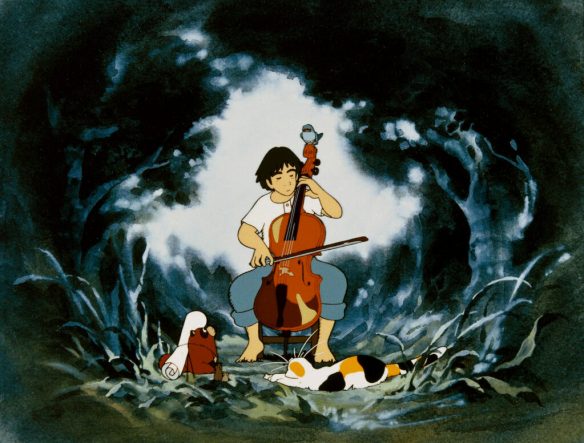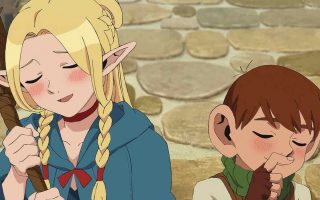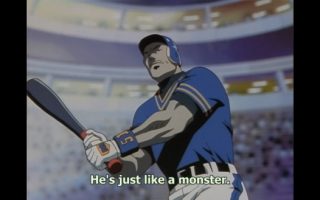Hello folks, and welcome the heck back to Wrong Every Time. This week our film screenings ranged from classics of western cinema to modern spinetinglers, alongside one of my few outstanding theatrical projects spearheaded by either of Ghibli’s legendary directors. I believe I’ve actually seen every Miyazaki film at this point, but still have both Grave of the Fireflies and the intriguing mixed-media project The Story of Yanagawa’s Canals outstanding among Takahata’s projects. I’m basically waiting for the right mental state to watch Grave of the Fireflies, but in the meantime was happy to savor a lighter project embodying many of Takahata’s finest qualities. Let’s start with that feature, as we burn down a fresh Week in Review!
First up this week was Gauche the Cellist, Isao Takahata’s adaptation of Kenji Miyazawa’s short story. The hour-long film follows Gauche, a mediocre cellist whose poor play is undercutting his local orchestra’s practice for an upcoming performance. Over a series of four nights, Gauche is visited at his home by an array of local animals, each of which offers requests and guidance for his cello performance. Ultimately, Gauche is able to integrate all of their lessons, and performs with his orchestra to stunning success.
Gauche is a quiet, pastoral, and eminently warm-hearted feature, a charming slice of pure Takahata excellence. Alongside Takahata’s writing and direction, Gauche was largely produced by two other artists, with Shunji Saida handling key animation and Takamura Mukuo offering the painted backgrounds. Both artists put in incredible efforts here; Mukuo’s backgrounds are richly detailed and inviting, while Saida’s animation varies gracefully between naturalistic animal forms and anthropomorphized flourishes, alongside carefully articulating the nuances of Gauche’s cello play.
All in all, Gauche the Cellist offers a flawless slice of proto-Ghibli excellence, feeling much like a World Masterpiece Theater production condensed into one fluidly animated hour of drama. It brings to mind an era where animators drew widely in their influences, embracing venerable narrative forms and celebrating classical music as a natural complement to animation’s visual drama. Most of the best works of animation seem untethered from the commercial demands of their era, works of pure creator passion like On-Gaku or Rainbow Fireflies. Tidy and timeless, Gauche the Cellist is about as good as it gets.
After that we watched The Bridge Curse 2: Ritual, which I personally would have titled The Bridge Curse 2: Bigger, Badder, and Bridgier. Though I suppose that title wouldn’t accurately describe the film in question, as The Bridge Curse 2 actually dispenses with bridges and their attendant curses altogether, instead centering on a school that is known for both repelling external spirits and trapping those already inside. This makes it the perfect venue for a group of college kids working on their horror AR game, who do their best to conjure the local ghosts and reap some predictably terrible consequences.
The Bridge Curse 2 is built around one fundamentally excellent idea: the natural synergy of Augmented Reality games and traditional occult rituals, which are themselves frequently game-adjacent in nature. Stuff like summoning Bloody Mary in a mirror was basically the AR games of the pre-smartphone era, and The Bridge Curse 2 makes effective use of this conceit, offering clever digital interpretations of old ritual standbys, and thereby blurring the lines between what is intended in-game horror and what spirits actually wander the halls. Add a sprinkling of cleanly executed scares, and you end up with a fine slice of horror cinema, even if there are no bridges in attendance.
Next up was Rancho Notorious, a ‘50s western directed by Fritz motherfucking Lang, who I had no idea enjoyed a late-career Hollywood film run. The master is here accompanied by the imposing Marlene Dietrich, playing the warden of a fantastical criminal hideout known as Chuck-a-Luck. Hot on the trail of his wife’s killer, Vern Haskell (Arthur Kennedy) meets up with acclaimed gunslinger Frenchy Fairmont (Mel Ferrer), who eventually leads Vern back to the hideout. There, Vern ingratiates himself amongst the regular crew while seeking the answer to his burning question – which of these scumbags was the one who killed his wife?
Oh man, what a fun watch this was! Fritz Lang’s cinematography is magnificent, Kennedy and Ferrer make for dynamic screen rivals, the script is witty and energetic, and Dietrich is absolutely fucking unstoppable. Her commanding performance here makes it obvious how she’d manage a corral of murderous ruffians, while also making it practically impossible not to fall in love with her. Arthur Kennedy spends the first third of the feature marinating in rage while pursuing this mysterious baroness, yet within minutes of arriving at Chuck-a-Luck, all we can really feel is despair at the senselessness of the encroaching violence. Both Lang and the leads deftly manipulate the audience’s sympathies, selling the intimacy and yearning implicit in each of Rancho Notorious’ far-flung life stories, only to pull the rug out from under us when those stories come in conflict. A casual masterpiece by one of cinema’s greatest masters.
We then watched In A Violent Nature, an interesting spin on slasher movie convention. Rather than following a group of ill-fated college kids as they awaken and are swiftly dismantled by a supernatural killer, this feature actually sets us behind the shoulders of the killer himself, following his journey from resurrection through the fulfillment of his terrible purpose.
It’s an idea that sounds obvious, perhaps even easy to execute, but further examination reveals its inherent genre-incompatible qualities. Slasher movies thrive on implication and suspense, but when the movie’s already framed from the killer’s shoulder, there’s no real question of what is hunting our party, or when the killer will strike. Additionally, you lose the standard narrative beats of following your victims from humble beginnings to heroic conclusions, instead following a villain who might as well be an elemental force, given their implacable perspective and unmatchable strength.
In A Violent Nature is smart enough to understand what it is sacrificing, and thus makes sure to replace these genre standards with substitutes that allow its distinctive twist to shine. Though it follows pretty much the exact narrative structure of your average Friday the 13th sequel, the film actually has more in common with slow cinema and French extreme horror than slashers in terms of its pacing, cinematography, and payoffs. Slow-burning sequences of our killer wandering the woods offer a new style of nervous anticipation, long held shots foster tooth-grinding preludes to violence, and when the kills arrive, they are executed with such blunt, meaty ferocity as to shock even though their arrival is plainly imminent.
With its perspective thus set and propensity for vicious payoff assured, In A Violent Nature finds a new tenor of horror in our anticipation of the ensuing bloodshed, as well as the unflinching intensity of its kills. And because we are following the killer rather than the victims, the fragments of slasher script we are provided fail to cohere into a journey of rising over adversity; our heroes are just as outgunned and helpless at the end as they are at the start, meaning the film is free to marinate in a cruelly extended outro, as we alongside the cast wait for the ax to fall. In A Violent Nature could have easily been simply a novel proof of concept, but it instead fully explores the tonal and structural implications of that concept, resulting in a film that makes its audience feel genuinely, gloriously unsafe.




